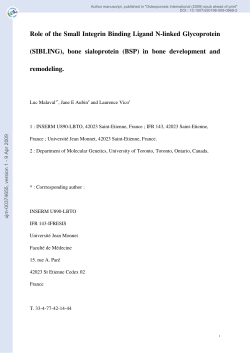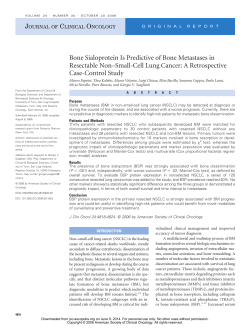
Biochemical Bone Marker ELISA kits Sclerostin Visit our website: www.oxfordbiosystems.com
Visit our website: www.oxfordbiosystems.com No.29 Biochemical Bone Marker ELISA kits Sclerostin Sclerostin Bone Sialoprotein Cathepsin K DKK-1 Osteoprotegerin (OPG) sRANKL Tartrate-resistant acid phosphatase or acid phosphatase 5, tartrate resistant (ACP5 or TRAP) Vitamin D N-telopeptide (NTx) C-telopeptide (ICTP and CTx) Propeptide of type I procollagen N terminal (PINP) Deoxypyridinoline (Dpd) Canonical Wnt-signalling plays an important role in the regulaton of bone homeostasis by promoting the development of osteoblasts. Negative regulators of the Wnt pathway are potential therapeutic targets regarding diseases with enhanced bone resorption like osteoporosis or myeloma bone disease. One of these molecules is Sclerostin, which is of special interest, because of its high bone specificity. Sclerostin, a 190 residue, secreted glycoprotein of the cystine-knot family acts by binding to the Wnt-coreceptor LRP5 thus preventing the binding of Wnt molecules. Because of its high bone specificity, antibodies against Sclerostin are found to be very promising therapeutic agents in disease with elevated bone resorption. Osteocalcin Bone Sialoprotein Bone Specific Alkaline Phosphates Bone Sialoprotein (BSP) is a glycoprotein, which accounts for approximately 10% of the noncollagenous matrix protein of bones. BSP (as well as other glycoproteins such as osteonectin and osteopontin) plays a regulatory role in bone metabolism, e.g. the control of mineralisation in the formation of new bones and bone resorption. BSP contains an Arg-GlyAsp (RGD)-sequence, which is essential for the attachment of cells to bone surfaces. BSP has important functions in the initiation of hydroxyapatite- Parathyroid hormone (PTH) Calcitonin Glycosaminoglycans (GAGs) Cartilage Oligomeric Matrix Protein (COMP) Fibroblast growth factor 23 (FGF-23) crystallisation and in the interaction between bone cells and the mineralised bone matrix. BSP can be detected in mineralising connective tissue, where the osteoblasts are primarily formed. It has however also been detected in trophoblasts and to a lesser extent in decidua cells. Tumors, which result in calcification and formation of metastases in the bones, can also express BSP. It has been shown that BSP expression in human breast cancer is associated with skeletal metastases. BSP expression has also been detected in small cell bronchial carcinomas. Cathepsin K Cathepsin K is a highly expressed cysteine protease in osteoclasts that plays an essential role in the degradation of protein components of bone matrix. This protease cleaves both helicoidal and telopeptide regions of collagen type 1, the major type of collagen in bone remodelling and resorption. It seems to be a valuable marker for various bone diseases, such as Rheumatoid Arthritis, Postmenopausal Osteoporosis and Paget’s Disease. Continued Crosslinks 29 · 2010 1 Biochemical Bone Marker ELISA kits DKK-1 Dickkopf-1 (DKK-1) is a 28,672 Da secreted protein that acts as soluble inhibitor of the Wnt-signalling pathway. This pathway contains lipid-modified glycoproteins that activate cell surface receptor-mediated signal transduction to regulate cell activities like: cell fate, proliferation, migration, polarity and gene expression. DKK-1 regulates developmental processes of all kinds. Thus, DKK-1 is also involved in the regulation of bone metabolism as it effects osteoblast differentiation and in regulation of tumourgenetic activity. Osteoprotegerin (OPG) Osteoprotegerin (OPG), also known as osteoclastogenesis inhibitory factor (OCIF), is a cytokine, which can inhibit the production of osteoclasts. It is a member of the tumour necrosis factor (TNF) receptor superfamily. It is a basic glycoprotein comprising 401 amino acid residues arranged into 7 structural domains. It is found as either a 60 kDa monomer or 120 kDa dimer linked by disulfide bonds. Osteoprotegerin inhibits the differentiation of osteoclast precursors (osteoclasts are related to monocyte/ macrophage cells and are derived from granulocyte/macrophage-forming colony units [CFU-GM]) into osteoclasts and also regulates the resorption of osteoclasts in vitro and in vivo. Osteoprotegerin is a RANK homolog, and works by binding to RANKL on osteoblast/stromal cells, thus blocking the RANKL-RANK ligand interaction between osteoblast/stromal cells and osteoclast precursors. This has the effect of inhibiting the differentiation of the osteoclast precursor into a mature osteoclast. Recombinant human osteoprotegerin specifically acts on bone, increasing bone mineral density and bone volume. Osteoprotegerin has been used experimentally to decrease bone resorption in women with postmenopausal osteoporosis and in patients with lytic bone metastases. Osteoprotegerin production is stimulated in vivo by the female sex hormone estrogen, as well as the osteoporosis drug, strontium ranelate. sRANKL RANKL (Receptor Activator for Nuclear Factor kB Ligand), also known as TNF-related activation-induced cytokine (TRANCE), osteoprotegerin ligand (OPGL), and ODF (osteoclast differentiation factor), is a molecule important in bone metabolism. This natural and necessary surfacebound molecule activates osteoclasts, cells involved in bone resorption. Overproduction of RANKL is implicated in a variety of degenerative bone diseases, such as rheumatoid arthritis and psoriatic arthritis. RANKL also has a function in the immune system, where it is expressed by T helper cells and is thought to be involved in dendritic cell maturation. This protein was shown to be a dentritic cell survival factor and is involved in the regulation of T cell-dependent immune response. T cell activation was reported to induce expression of the RANKL gene and lead to an increase of osteoclastogenesis and bone loss. This protein was shown to activate antiapoptotic kinase AKT/PkB through a signalling complex involving SRC kinase and tumor necrosis factor receptor-associated factor (TRAF) 6, which indicated this protein may have a role in the regulation of cell apoptosis. Targeted disruption of the related gene in mice led to severe osteopetrosis and a lack of osteoclasts. The deficient mice exhibited defects in early differentiation of T and B lymphocytes, and failed to form lobulo-alveolar mammary structures during pregnancy. Two alternatively spliced transcript variants have been found. Tartrate-resistant acid phosphatase or acid phosphatase 5, tartrate resistant (ACP5 or TRAP) Tartrate-resistant acid phosphatase or acid phosphatase 5, tartrate resistant (ACP5 or TRAP) is a glycosylated monomeric metalloenzyme expressed in mammals. It has a molecular weight of approximately 35kDa, a basic isoelectric point (7.6-9.5), and optimal activity in acidic conditions. TRAP is synthesized as latent proenzyme and activated by proteolytic cleavage and reduction. It is differentiated by other mammalian acid phosphatases by its resistance to inhibition by tartrate, molecular weights and characteristic purple colour. The mechanism of phosphate ester hydrolysis by TRAP is through a nucleophilic attack mechanism, whereby, catalysis occurs with the binding of a phosphatesubstrate to the Fe2+ in the active site of TRAP. This is then followed by a nucleophilic attack by a hydroxide ligand on the bound phosphorus atom, resulting in cleavage of the phosphate ester bond and production of an alcohol. The exact identity and mechanism of the hydroxide ligand is unclear, but it is thought to be either a hydroxide that bridges the metal ions within the active site or a terminal hydroxide bound to Fe3+, with confl icting reports for both mechanisms. Vitamin D Vitamin D is a steroid hormone involved in the intestinal absorption of calcium and the regulation of calcium homeostasis. There are two different forms of Vitamin D, named D3 and D2, which are very similar in structure. The D2 is a synthetic product, which is predominantly absorbed by fortified food. Physiological Vitamin D3 levels result not only from dietary uptake but also by biosynthesis of 7-dehydrocholesterol and UV-light in skin because of sun exposure. Vitamin D deficiency can result from inadequate intake coupled with inadequate sunlight exposure, disorders that limit its absorption, conditions that impair conversion of vitamin D into active metabolites, such as liver or kidney disorders, or, rarely, by a number of hereditary disorders. Deficiency results in impaired bone mineralization, and leads to bone softening diseases, rickets in children and osteomalacia in adults, and possibly contributes to osteoporosis. Research has indicated that vitamin D Continued Crosslinks 29 · 2010 2 Biochemical Bone Marker ELISA kits deficiency is linked to colon cancer; confl icting evidence links vitamin D deficiency to other forms of cancer. In the liver, the vitamin is hydroxylated to 25-hydroxyvitamin D (25-OH Vitamin D), the major circulating metabolite of Vitamin D. Although 1,25-(OH)2 Vitamin D portrays the biological active form of Vitamin D, which is synthesized in the kidney, it is widely accepted that the measurement of circulating 25-OH Vitamin D provides better information with respect to patients’ Vitamin D status and allows its use in diagnose hypovitaminosis. The concentration of 25-OH Vitamin D decreases with age and a deficiency is common among elderly persons. Clinical applications of 25-OH Vitamin D measurements are the diagnosis and therapy control of postmenopausal osteoporosis, rickets, osteomalacia, renal osteodystrophy, pregnancy, neonatal hypocalcemia and hyperparathyroidism. In addition, a prevalence of subclinical Vitamin D deficiency has been discussed lately in different European countries. Vitamin D intoxication mostly occurs during a large intake of pharmaceutical preparations of Vitamin D and may lead to hypercalcemia, hypercalcuria and nephrocalcinosis in susceptible infants. N-telopeptide (NTx) NTx provides the measurement of the cross-linked N-telopeptides of bone type I collagen (NTx). NTx is a specific biochemical indicator of bone resorption that is generated as the result of osteoclast activity on bone. The NTx molecule is specific to bone due to the unique amino acid sequence and orientation of the crosslinked alpha-2 (I) N telopeptide. C-telopeptide (ICTP) ICTP is a quantitative measurement of a cross-linked carboxyterminal telopeptide of type I collagen in human serum. ICTP indicates pathological bone degradation specifically without being influenced by physiological bone turnover. It also provides fi rst-line detection of bone involvement in cancer and multiple myeloma and helps to predict disease severity in rheumatoid arthritis. C-telopeptide (CTx) Urine CrossLaps® detects fragments of collagen type I generated during osteoclastic bone resorption. The assay can be used for quantification of bone resorption and assessment of bone loss. The test is specific for an epitope in the amino acid sequence Glu-Lys-Ala-HisAsp-ß-Gly-Gly-Arg derived from the C-telopeptide of the a1 chain of type I collage. Propeptide of type I procollagen N terminal (PINP) PINP is a quantitative measurement of intact aminoterminal propeptide of type I procollagen in serum, an indicator of osteoblastic activity in bone. PINP is intended to be used as an aid in the management of postmenopausal osteoporosis. PINP detects increased bone turnover, and can be used to identify patients at risk of fracture. Also helps to monitor antiresorptive and anabolic therapy in patients with osteoporosis. Deoxypyridinoline (Dpd) Deoxypyridinoline (Dpd) occurs mainly in Type I collagen of bone. After the formation of the Type I collagen matrix, the action of lysyl oxidase on two hydroxylysine and a lysine residue result in the formation of a Dpd cross link between two triple helical strands of collagen. In the process of bone degradation, Dpd is released into the blood circulation and cleared by the kidneys. Hence Dpd has been shown to be a biochemical indicator of bone resorption. Osteocalcin Osteocalcin or bone Gla protein (BGP) is the major non-collagen protein of the bone matrix. It has a molecular weight of 5800 Da and contains 49 amino-acids, including 3 residues of gamma carboxyl glutamic acid. Osteocalcin is synthesized in the bone by the osteoblasts. After production, it is partly incorporated in the bone matrix and the rest is found in the blood circulation. The exact physiological function of osteocalcin is still unclear. A large number of studies show that the circulating levels of osteocalcin reflect the rate of bone formation. Bone Specific Alkaline Phosphates The skeletal, or bone-specific, isoform of alkaline phosphatase is a tetrameric glycoprotein found on the surface of osteoblast cells. Osteoblast are a type of cell responsible for lying down the protein matrix of bone, on which calcium salts (particularly phosphates) are deposited. The function of bonespecific alkaline phosphatase (BAP) is not clearly understood, although it’s been shown to be a biochemical indicator of bone turnover. Parathyroid hormone (PTH) Parathyroid hormone (PTH) is secreted by the parathyroid glands as a polypeptide containing 84 amino acids. It acts to increase the concentration of calcium in the blood by acting upon parathyroid hormone receptor in three parts of the body. Regulation of serum calcium, serum phosphate and vitamin D synthesis. Calcitonin Calcitonin is a 32-amino acid linear polypeptide hormone that is produced primarily by the Para follicular cells of the thyroid. It acts to reduce blood calcium, opposing the effect of parathyroid hormone. The hormone participates in calcium and phosphorus metabolism by inhibiting Ca++ absorption by the intestines, inhibiting osteoclast activity in bones, inhibiting phosphate reabsorption by kidney tubules and increasing absolute Ca++ and Mg++ reabsorption by the kidney tubules. Continued Crosslinks 29 · 2010 3 Biochemical Bone Marker ELISA kits Glycosaminoglycans (GAGs) The most abundant heteropolysaccharides in the body are the glycosaminoglycans (GAGs). They are located primarily on the surface of the cells or in the extra cellular matrix. As an example, cartilage is composed to a large extent of GAGs, which are the dominant part of the proteoglycan Aggrecan. Cartilage Oligomeric Matrix Protein (COMP) Cartilage Oligomeric Matrix Protein (COMP) is a high molecular weight, multi-submit protein originally isolated from cartilage. The protein is abundant in cartilage but also found in tendon and other tissues. The protein belongs to the thrombospondin family. Measurement of intact COMP and fragments in synovial fluid or serum have been shown to correlate to cartilage destruction in rheumatoid arthritis and osteoarthritis patient studies. Fibroblast growth factor 23 (FGF-23) Fibroblast growth factor 23 (FGF-23) is a recently discovered, novel member of a large family of related proteins. Its gene encodes a 251 amino acid protein. The amino-terminal portion of FGF-23 (aa 1-24) is hydrophobic and is likely to serve as a signal peptide allowing its secretion into the blood circulation. Its carboxyl-terminal portion (aa180-251) shares only limited amino acid homology with other members of the FGF family proteins. The measurement of human FGF-23 in the blood circulation is likely to provide an important diagnostic tool for patients with a variety of different hypophosphatemic disorders, including oncongenic ostemalacia, X-linked hypophosphatemic rickets, and autosomal dominant hypophospatemic rickets. Furthermore, the sensitive measurement of FGF-23 is likely to provide novel insights into the regulation of bone and mineral homeostasis. $ Faxback: 01865 873210 FURTHER INFORMATION 3 Please send information on the following products: For further information on any of the articles in this issue, or on our products or service, please use this faxback form, or contact us: Oxford Biosystems 40 Church Road, Wheatley Oxford, OX33 1NB, UK Tel: 01865 876543 Fax: 01865 873210 Email: info@oxfordbiosystems.com www.oxfordbiosystems.com 3 Please send product list Name Address Postcode Telephone: Fax: Email: Crosslinks 29 · 2010 4
© Copyright 2025





















